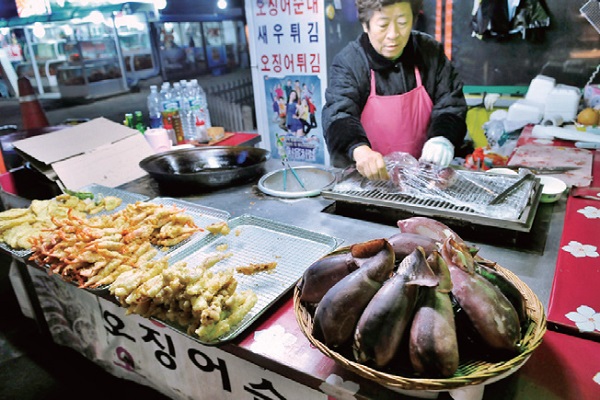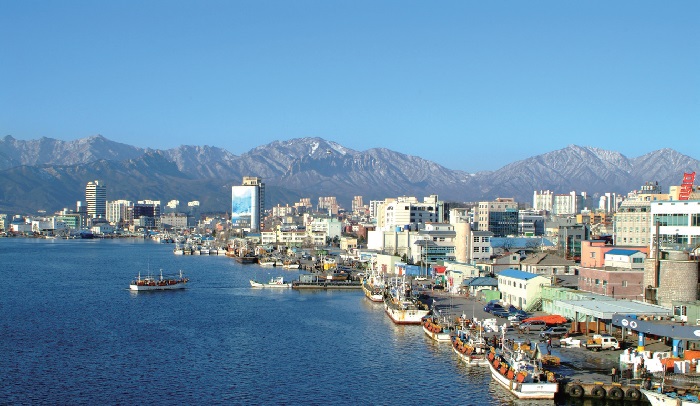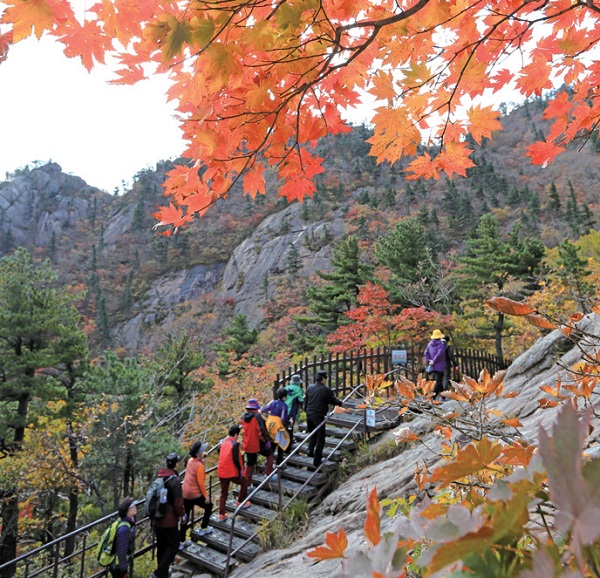View this article in another language
- 한국어
- English
- 日本語
- 中文
- العربية
- Español
- Français
- Deutsch
- Pусский
- Tiếng Việt
- Indonesian
Not far from the border with North Korea, the East Sea fishing port of Sokcho is best known as the gateway to Seoraksan National Park, considered by many to be Korea’s most spectacular mountain park. The town itself is not large, but it is an important fishing port, and the constant influx of tourists gives it a surprisingly lively feel. Its dramatic location, wedged between the East Sea and Mt. Seoraksan, make this a very pleasant place to spend a day or two.

Sokcho Town
With the East Sea in the foreground and Mt. Seoraksan forming the backdrop, the city boasts some fine scenery. Of particular scenic interest are the town’s two large lagoons, Yeongnangho and Cheongchoho, which are popular leisure spots favored by local walkers and joggers. The latter was also the primary venue for the 1999 Gangwon International Tourism Expo, and is where you’ll find the landmark Expo Tower and a visually striking commemorative hall. From the top of the tower, visitors are provided panoramic views of Cheongchoho, Sokcho and Mt. Seoraksan. Don’t miss it.
Sokcho’s Jungang Market is a pretty vibrant place, too, and a good place to score raw fish. It’s also famous for its Korean-style fried chicken, or dak gangjeong, which are knots of chicken meat fried and covered in a tangy sauce.
Along the coast, you’ll find a couple of harbors used by the local fishing fleet, including Dongmyeonghang and Daepohang. Dongmyeonghang is also where to go for the best sunrises in town—look for the Yeongeumjeong, two traditional pavilions, one atop a hillock overlooking the sea and another on a wave-beaten rock in the sea itself, attached to the land via a pedestrian suspension bridge.
Abai Village
One particular neighborhood is Abai Village, located on a strip of land between Cheongchoho Lake and the East Sea. The fishing village was founded after the Korean War by villagers who had fled their homes in North Korea’s Hamgyeongdo region. Most residents are either the original founders or their descendants. The village’s name, abai, means “father” in the dialect of Korean spoken in Hamgyeongdo, and is a reference to both the origins of the community and the large number of elderly who call it home. The neighborhood looks like it stepped straight out of a 1970s Korean TV drama (in fact, it was actually used as the set of a popular 2000 drama, “Autumn in My Heart”), which lends it much of its charm.

Seoraksan National Park
Spread some 398 square kilometers over three counties, Seoraksan National Park is Korea’s most spectacular mountain park. Mt. Seoraksan (“Snow Peak”) is, in fact, the South Korean section of North Korea’s famous Kumgangsan Mountains, which Koreans have lauded for their beauty for centuries. This is a land of high granite peaks, sculpted by the elements into spectacular shapes, overlooking the white capped expanses of the East Sea. Imagine the mythical landscapes of ancient Korean and Chinese watercolor paintings, and you’ll have a good idea of what awaits you. It’s enchanting any time of year, but especially so in autumn, when the hillsides are ablaze in hues of red and gold, and in winter, when the park becomes a glistening, snow-covered wonderland. Home to 2,000 animal species, including the endangered Amur goral, and 1,400 rare plant species, the park was designated a UNESCO Biosphere Reserve in 1982.
Seoraksan National Park can be divided into three sectors. Outer Seorak is the region of the park closest to the sea, and is the most frequently visited part of the park. The western part of the park is called Inner Seorak, and is further subdivided into North Inner Seorak and South Inner Seorak. Inner Seorak is more remote, less touristic and more natural. The park contains several peaks over 1,200 meters, including Daecheongbong Peak (1,708 meters), Korea’s third highest peak.
In addition to the natural splendor, the park is also home to two major Buddhist temples, Sinheungsa and Baekdamsa.

* Article from Korea Magazine (October 2014)

Ojingeo sundae, a sausage made from filling a squid with noodles and vegetables
Sokcho Town
With the East Sea in the foreground and Mt. Seoraksan forming the backdrop, the city boasts some fine scenery. Of particular scenic interest are the town’s two large lagoons, Yeongnangho and Cheongchoho, which are popular leisure spots favored by local walkers and joggers. The latter was also the primary venue for the 1999 Gangwon International Tourism Expo, and is where you’ll find the landmark Expo Tower and a visually striking commemorative hall. From the top of the tower, visitors are provided panoramic views of Cheongchoho, Sokcho and Mt. Seoraksan. Don’t miss it.
Sokcho’s Jungang Market is a pretty vibrant place, too, and a good place to score raw fish. It’s also famous for its Korean-style fried chicken, or dak gangjeong, which are knots of chicken meat fried and covered in a tangy sauce.
Along the coast, you’ll find a couple of harbors used by the local fishing fleet, including Dongmyeonghang and Daepohang. Dongmyeonghang is also where to go for the best sunrises in town—look for the Yeongeumjeong, two traditional pavilions, one atop a hillock overlooking the sea and another on a wave-beaten rock in the sea itself, attached to the land via a pedestrian suspension bridge.
Abai Village
One particular neighborhood is Abai Village, located on a strip of land between Cheongchoho Lake and the East Sea. The fishing village was founded after the Korean War by villagers who had fled their homes in North Korea’s Hamgyeongdo region. Most residents are either the original founders or their descendants. The village’s name, abai, means “father” in the dialect of Korean spoken in Hamgyeongdo, and is a reference to both the origins of the community and the large number of elderly who call it home. The neighborhood looks like it stepped straight out of a 1970s Korean TV drama (in fact, it was actually used as the set of a popular 2000 drama, “Autumn in My Heart”), which lends it much of its charm.

Port of Dongmyeonghang © Yonhap News
Seoraksan National Park
Spread some 398 square kilometers over three counties, Seoraksan National Park is Korea’s most spectacular mountain park. Mt. Seoraksan (“Snow Peak”) is, in fact, the South Korean section of North Korea’s famous Kumgangsan Mountains, which Koreans have lauded for their beauty for centuries. This is a land of high granite peaks, sculpted by the elements into spectacular shapes, overlooking the white capped expanses of the East Sea. Imagine the mythical landscapes of ancient Korean and Chinese watercolor paintings, and you’ll have a good idea of what awaits you. It’s enchanting any time of year, but especially so in autumn, when the hillsides are ablaze in hues of red and gold, and in winter, when the park becomes a glistening, snow-covered wonderland. Home to 2,000 animal species, including the endangered Amur goral, and 1,400 rare plant species, the park was designated a UNESCO Biosphere Reserve in 1982.
Seoraksan National Park can be divided into three sectors. Outer Seorak is the region of the park closest to the sea, and is the most frequently visited part of the park. The western part of the park is called Inner Seorak, and is further subdivided into North Inner Seorak and South Inner Seorak. Inner Seorak is more remote, less touristic and more natural. The park contains several peaks over 1,200 meters, including Daecheongbong Peak (1,708 meters), Korea’s third highest peak.
In addition to the natural splendor, the park is also home to two major Buddhist temples, Sinheungsa and Baekdamsa.

* Article from Korea Magazine (October 2014)